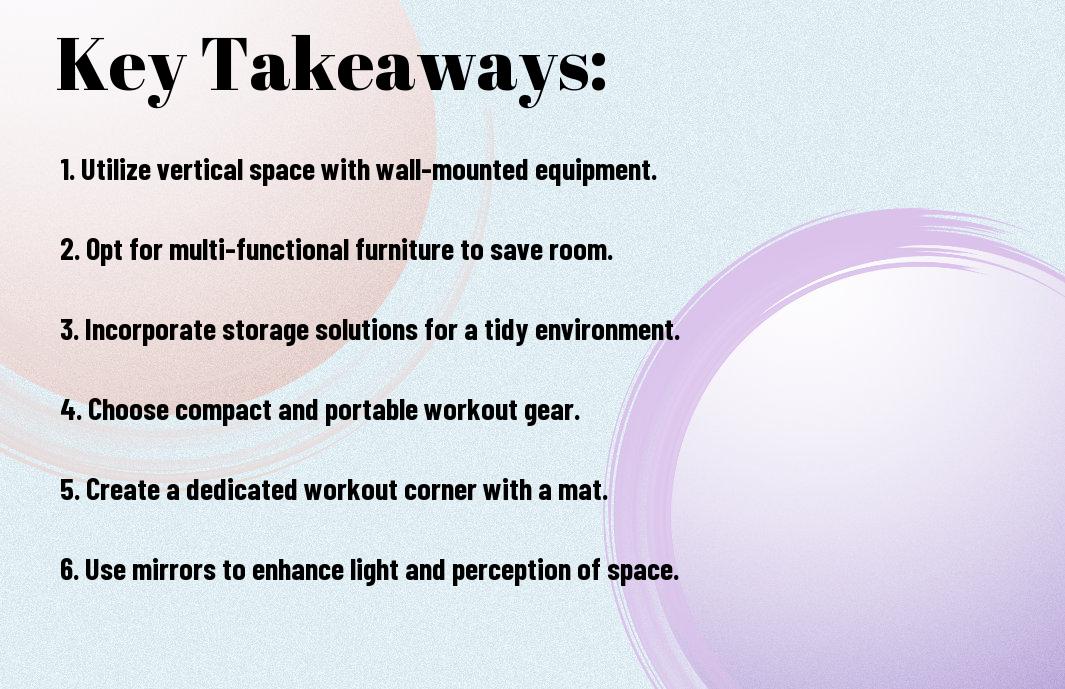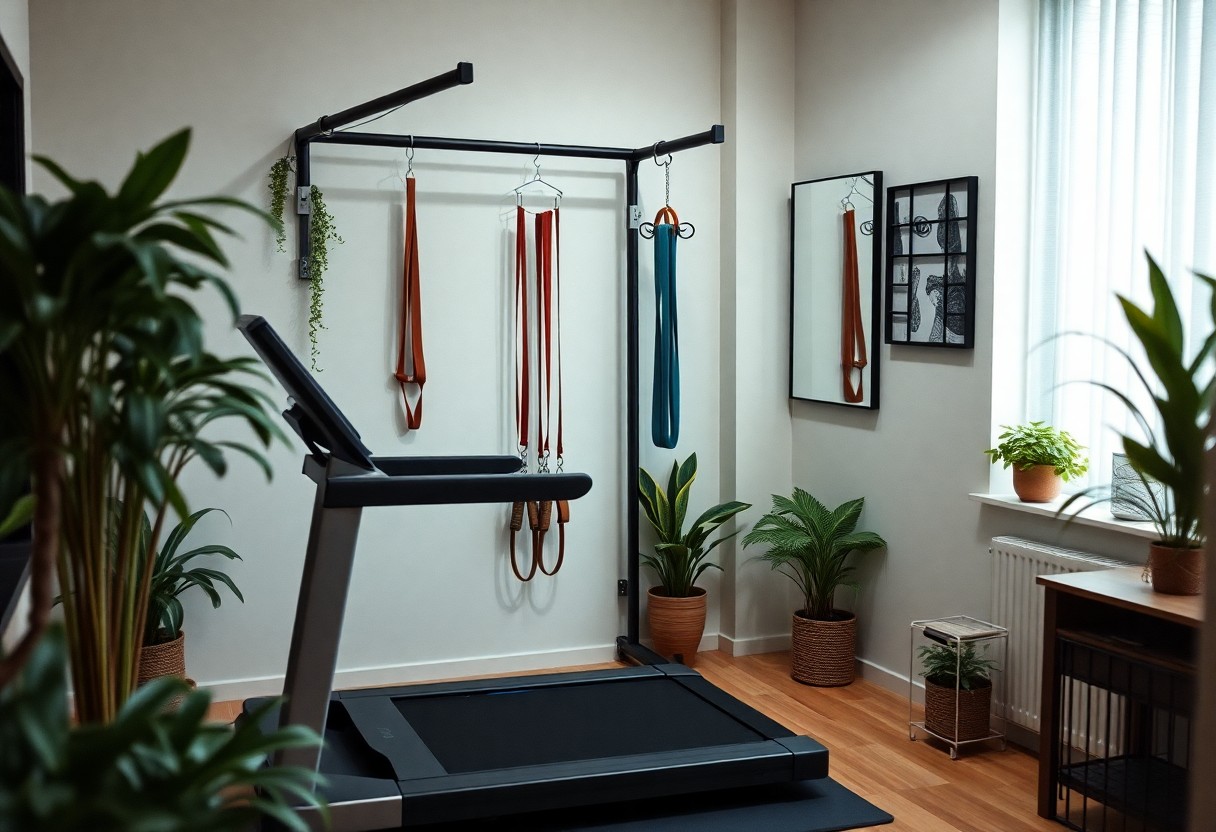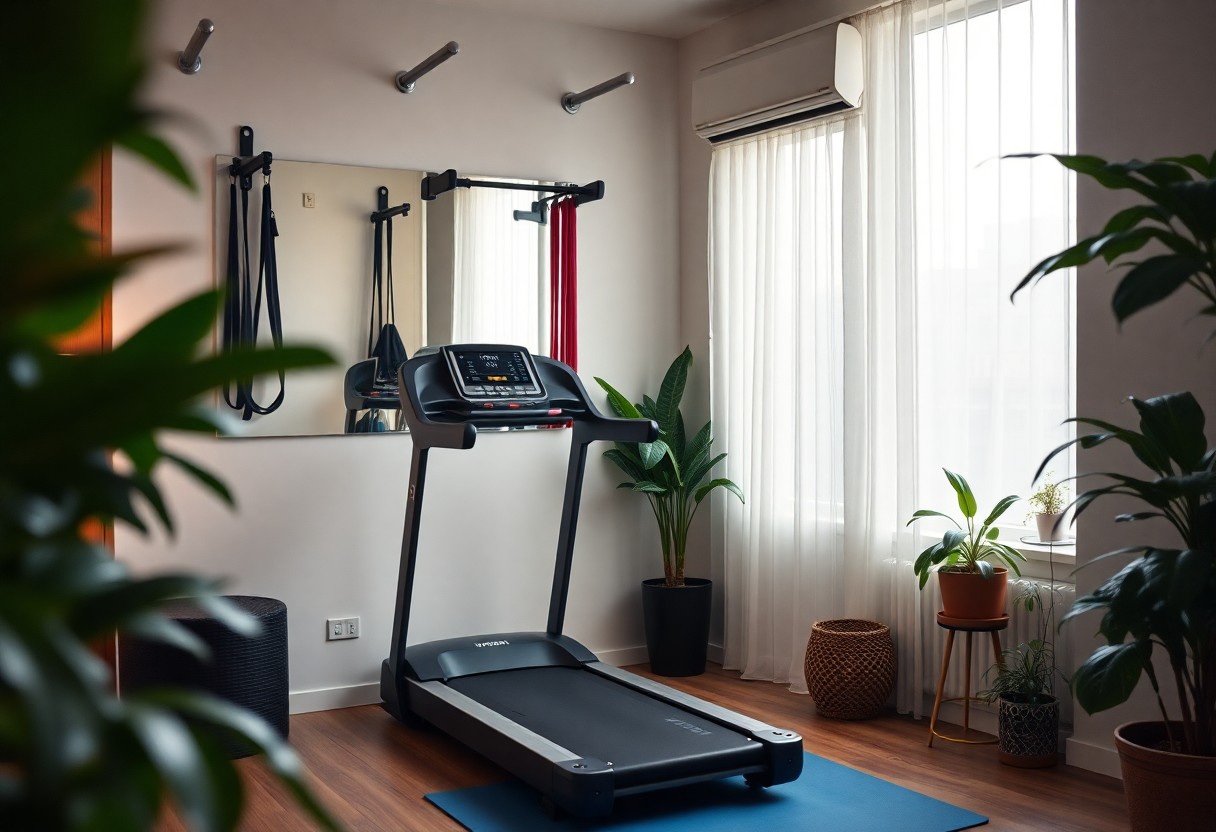You want to stay fit, but limited space is holding you back. You can’t let that stop you. With a little creativity, you can create a fully functional home gym in even the smallest areas. You’ll learn how to optimize your space and build a gym that suits your needs, without sacrificing safety or efficiency. You’ll be able to work out effectively, achieving your fitness goals in the comfort of your own home.
Key Takeaways:
To create an effective home gym in a small area, consider the following points:
- Optimize your space by choosing multi-functional equipment that serves more than one purpose, such as a bench that can be used for both weightlifting and as a step for cardio exercises.
- Utilize vertical space by installing wall-mounted equipment like pull-up bars, storage racks, and mirrors to keep the floor clear and create a sense of openness.
- Invest in compact equipment specifically designed for small spaces, such as folding treadmills, compact ellipticals, or resistance bands that can be easily stored away when not in use.
- Consider modular designs that allow you to customize your gym layout and make the most of your available floor space, such as interlocking mats or modular storage units.
- Incorporate technology into your home gym, such as fitness apps, virtual trainers, or smart mirrors, to enhance your workout experience and provide variety in a small training area.

Assessing Your Space
Before you start designing your home gym, take a close look at the area you have to work with. Consider the dimensions and layout of the space to determine the best way to utilize it.
Measuring the Area
Around the space, you’ll find the length and width will help you decide on the equipment and layout. Take note of any irregularities in the space.
Identifying Obstacles
On the floor, you might notice obstacles like columns or heating vents that could impact your gym design.
Measuring the space carefully, you’ll identify potential hazards such as low ceilings or narrow doorways that could pose a danger to your safety while working out. You should also look for natural light sources and electrical outlets to ensure your gym is well-lit and functional.
Multifunctional Equipment
The key to a effective home gym in a small area is multifunctional equipment. You can use machines that serve multiple purposes, such as a weight bench that also functions as a pull-up bar.
Space-Saving Machines
Prior to selecting your equipment, consider foldable machines that can be easily stored away when not in use, allowing you to maximize your space.
Adjustable Gear
Following your decision to invest in multifunctional equipment, look for adjustable gear that can be modified to suit different exercises and fitness levels.
Equipment like adjustable dumbbells and resistance bands can be used for a variety of exercises, making them a cost-effective and space-efficient option for your home gym. You can use them to perform high-intensity workouts or low-impact exercises, depending on your fitness goals and personal preferences.
Vertical Training
After maximizing your floor space, consider vertical training to take your home gym to the next level. You can use your walls and ceiling to install equipment, making the most of your small area.
Wall-Mounted Equipment
About the space you have, you can choose from various wall-mounted equipment such as pull-up bars, resistance bands, and foldable benches to create a versatile workout area.
Ceiling-Mounted Options
Along with wall-mounted equipment, you can also utilize your ceiling to install pull-up bars, ropes, or even a heavy-duty ceiling mount for your Punching Bag, which will allow you to perform a full-body workout without taking up too much floor space.
It is crucial to ensure that your ceiling can support the weight of the equipment and your body to avoid any dangerous accidents. You should also consider the height and stability of the equipment to ensure a safe and effective workout. By installing ceiling-mounted options, you can create a challenging and varied workout routine that will help you achieve your fitness goals.
DIY Solutions
Unlike traditional gyms, your home gym can be crafted with creativity and resourcefulness. You can transform your small space into a functional workout area with a little ingenuity.
Repurposed Materials
The simplest way to start is by utilizing items you already own, such as old furniture or equipment, to create your home gym. You can use wooden crates as shelves or old tires as weights.
Budget-Friendly Ideas
Among the most effective ways to build your home gym is to shop smart and opt for affordable equipment. You can find cheap alternatives to expensive gym machines, such as resistance bands or free weights.
Indeed, with a little creativity, you can create a well-equipped home gym without breaking the bank. You can also consider shopping second-hand or building your own equipment to save money. By doing so, you’ll be able to focus on your fitness goals without worrying about the financial burden of expensive gym memberships or equipment.

Smart Storage
Keep your home gym organized with clever storage solutions. You can find inspiration on 33 Best Small home gym ideas in 2024 to maximize your space.
Hidden Compartments
One way to optimize storage is by utilizing hidden compartments.
| Compartment | Purpose |
|---|---|
| Under-bed storage | For foldable equipment and accessories |
Foldable Equipment
One of the best space-saving solutions is investing in foldable equipment. You can easily store it away when not in use.
Further, foldable equipment is a game-changer for small home gyms. You can choose from a variety of space-efficient options, such as foldable treadmills or compact exercise bikes, allowing you to create a functional and safe workout space in even the smallest of areas.

Safety Considerations
Many home gyms are set up in small, confined spaces, which can lead to accidents and injuries if you don’t take necessary precautions. You need to think about your safety and the safety of others when creating your home gym.
Proper Ventilation
By ensuring good airflow in your home gym, you can prevent the buildup of carbon monoxide and reduce the risk of heat exhaustion. You should install a ventilation system or use a fan to keep the air circulating.
Injury Prevention
Among the most important aspects of setting up a home gym is preventing injuries. You should warm up before exercising and use proper form when lifting weights to avoid strains and sprains.
Considerations for injury prevention include using safety equipment, such as weights with safety locks and a good quality exercise mat, to reduce the risk of accidents and injuries. You should also know your limits and not push yourself too hard, as this can lead to serious injuries that can set back your fitness goals.
Conclusion
As a reminder, you’ve got the power to transform your small space into a functional home gym. You can maximize your area with creative ideas and equipment. Your home gym will serve you well, helping you stay fit and healthy. You’ll be able to work out efficiently, no matter the size of your space. With a little planning, you can achieve your fitness goals in the comfort of your own home.
FAQ
Q: What are the benefits of having a home gym in a small area?
A: Having a home gym in a small area provides convenience, saves time, and increases motivation to work out regularly. It also helps to avoid gym memberships and commuting time, allowing you to utilize the space for other activities. With a well-designed home gym, you can achieve your fitness goals in the comfort and privacy of your own home, regardless of the size of the area.
Q: How can I maximize a small space for a home gym?
A: To maximize a small space for a home gym, consider using wall-mounted equipment, folding machines, and multi-functional gear. You can also utilize vertical space by installing shelves, hooks, or storage units for your fitness accessories. Additionally, choose equipment with a small footprint, and select items that serve multiple purposes, such as a adjustable dumbbell set or a resistance band. This will help you create a functional and efficient workout area without feeling cramped.
Q: What types of equipment are suitable for a small home gym?
A: For a small home gym, opt for compact and versatile equipment such as resistance bands, jump ropes, or mini exercise balls. You can also consider investing in a foldable treadmill, a compact exercise bike, or a set of adjustable dumbbells. Bodyweight exercises, such as push-ups, squats, and lunges, are also an excellent way to work out without requiring any equipment at all. Ultimately, the key is to select equipment that fits your fitness goals, available space, and personal preferences.
Q: How can I ensure safety and comfort in my small home gym?
A: To ensure safety and comfort in your small home gym, consider the flooring, lighting, and ventilation of the space. Install a durable and non-slip flooring, such as rubber or interlocking tiles, to prevent injuries. Provide adequate lighting to illuminate the area, and maintain good ventilation to prevent overheating. You should also invest in a good quality mirror to monitor your form and technique, and have a first-aid kit on hand in case of emergencies. Lastly, keep the area clean and organized to prevent tripping hazards and distractions.
Q: Can I create a home gym in a non-traditional space, such as a garage or attic?
A: Yes, you can create a home gym in a non-traditional space, such as a garage or attic, with some creativity and planning. First, assess the space for its potential, considering factors such as ceiling height, flooring, and natural lighting. Then, choose equipment and furniture that fits the space and your fitness needs. You may need to invest in additional lighting, ventilation, or insulation to make the space comfortable and functional. With a little imagination, you can transform an underutilized area into a unique and effective home gym that meets your fitness goals and enhances your overall well-being.



